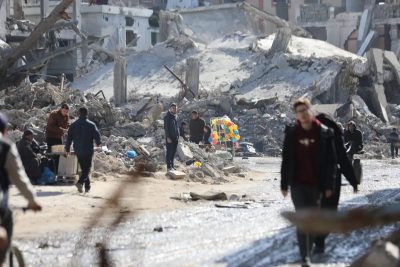Gaza Is Filled with War Debris, Hazardous Waste, Rubble, Disease
"Gaza has more rubble than Ukraine, Israeli 'ecocide' in Gaza poses long-term threats to health, livelihoods of Gazans

All Global Research articles can be read in 51 languages by activating the Translate Website button below the author’s name (only available in desktop version).
To receive Global Research’s Daily Newsletter (selected articles), click here.
Click the share button above to email/forward this article to your friends and colleagues. Follow us on Instagram and Twitter and subscribe to our Telegram Channel. Feel free to repost and share widely Global Research articles.
Give Truth a Chance. Secure Your Access to Unchained News, Donate to Global Research.
***
The ongoing Israeli war on Gaza has extended its devastation beyond the immediate human toll, reaching a state of “ecocide” that impacts the environment in often overlooked ways.
The relentless bombings and military operations have not only obliterated infrastructure but also wreaked havoc on Gaza’s ecosystem.
The first four months of the war have inflicted $18.5 billion in damage to Gaza’s infrastructure, destroying up to 66 per cent of buildings and half of the besieged strip’s trees, and resulting in the deaths of more than 36,000 Palestinians, according to the health ministry in Gaza, the World Bank and the UN.
Pollution in Gaza spans water, debris, and air, creating severe environmental impacts that pose long-term threats to the health and livelihoods of its inhabitants. Over 100,000 cubic metres of sewage and wastewater are being discharged daily onto land or into the Mediterranean Sea, according to the United Nations Environment Programme (UNEP).
The UNEP spokesperson told euronews.green in March that past marine pollution incidents in Gaza have led to elevated levels of chlorophyll and suspended organic matter in coastal waters, as well as gastrointestinal parasites. The current war is likely exacerbating these problems.
Simultaneously, solid waste is being disposed of in informal sites, where hazardous substances can seep into the porous soil and potentially contaminate Gaza’s primary water source, the aquifer. The rise in communicable diseases is alarming, driven by water scarcity, overcrowding, and a healthcare sector on the verge of collapse.
In the most overcrowded shelters in the south, there is only one toilet available for every 600 internally displaced persons, and access to running water is minimal, as reported by the American Near East Refugee Aid.
Debris and hazardous waste present a significant issue. As of January 7, UNEP estimated that the total amount of debris had reached 22.9 million tonnes, a number that has likely risen substantially since. This vast accumulation of rubble, combined with hazardous waste, is contaminating land and water sources, further exacerbating the humanitarian crisis. The United Nations Mine Action Service (UNMAS) estimated that by mid-April, the Gaza Strip contained approximately 37 million tonnes of debris, equating to 300 kilogrammes per square metre.
“Gaza has more rubble than Ukraine, and to put that in perspective, the Ukrainian front line is 600 miles [nearly 1,000 kilometres] long, and Gaza is 25 miles [40 km] long,” according to Mungo Birch, head of the UNMAS programme in the Palestinian territories.
“This rubble is likely heavily contaminated with UXO [unexploded ordnance], and its clearance will be further complicated by other hazards in the rubble,” Birch was quoted as saying in international press.
“There’s estimated to be over 800,000 tonnes of asbestos alone in the Gaza rubble.”
The war on Gaza is estimated to have produced between 420,265 and 652,552 tonnes of carbon dioxide equivalent, comparable to burning over 1.5 million barrels of oil, according to British-American study, which also found that the greenhouse gas emissions produced in the first two months of the Gaza war exceeded the annual carbon footprint of over 20 of the world’s most climate-vulnerable countries. The study estimates that the climate impact of the Israeli war in the first 60 days is equivalent to burning at least 150,000 tonnes of coal.
The use of white phosphorus by the Israeli army has further contributed to environmental contamination. White phosphorus is harmful to humans through all routes of exposure, and the smoke it produces contains phosphoric acids and phosphine, which are harmful to the eyes and respiratory tract, as stated by the World Health Ogranisation.
*
Note to readers: Please click the share button above. Follow us on Instagram and Twitter and subscribe to our Telegram Channel. Feel free to repost and share widely Global Research articles.
Featured image: A view of Palestinians as they try to continue their daily life amid Israeli attacks at the Jabalia Refugee Camp in Jabalia, Gaz on February 17, 2024 [Dawoud Abo Alkas – Anadolu Agency]

